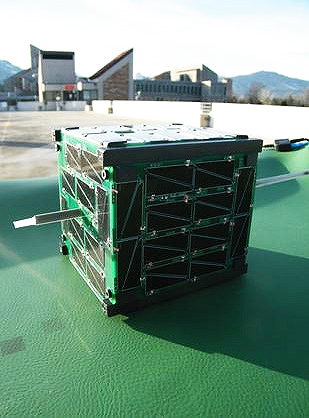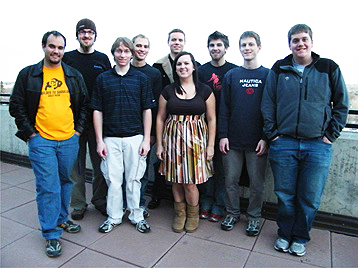
The Hermes Cubesat
Montana State designated its satellite as Explorer 1 Prime, or E1P. The name honors the launch and scientific discoveries of the Explorer-1 mission, which detected the Van Allen radiation belts more than 50 years ago. E1P will carry a miniature Geiger tube to measure the intensity and variability of the electrons in the Van Allen belts. The Kentucky vehicle is called KySat-1. It includes a camera to support a scientific outreach program intended for, but not limited to, Kentucky students in kindergarten through 12th grade. The satellite also has a 2.4-gigahertz industrial, scientific and medical band radio, which will be used to test high-bandwidth communications in the license-free portion of the S-band.

A Rubik’s Cube-sized communication satellite designed and built by a University of Colorado at Boulder undergraduate team has been selected for launch in November by NASA. Students, from left to right; Tyler Murphy, Mike Mozingo, Brian Roth, Zachary Cueso, Ricky Sadowski, Nicole Doyle, Mike Opland, Felix Bidner and Logan Finch. Not pictured: Patrick Hanschen. Photos courtesy COSGC
The three CubeSat satellites will be attached to the Taurus XL rocket in a mechanical system known as a PPOD developed by the California Polytechnic State University in partnership with Stanford University. Once the rocket reaches about 385 miles high, the satellites will be ejected from the PPOD and will spring off into separate orbits. The CU-Boulder satellite will be in contact with a COSGC ground station atop the Discovery Learning Center at the CU-Boulder engineering college. A second ground station is being built by the COSGC students in Longmont, about 15 miles northeast of Boulder, to monitor the high-speed communications data system, said Doyle. Of the 52 space grant consortiums in the United States, Colorado's has been active in designing, building and flying 10 sounding rocket payloads, three space shuttle payloads, a satellite and hundreds of balloon experiments in the past 20 years, Koehler said.

